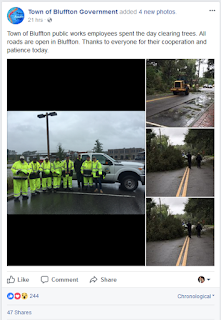This week’s earlier blog post showcases how Bluffton and Edisto Beach effectively used social media as part of their emergency communications plans. An article in the January issue of Uptown, showcased Mount Pleasant and North Charleston’s social media use last year during Hurricane Matthew.
Back in June, members of the SC Association of Municipal Power Systems participated in a session at their annual meeting that gave step by step plans for incorporating social media into emergency preparedness planning. Get the handout.
Still a little intimidated about hashtags? Don’t quite understand the difference between Twitter and Facebook? Not sure how to grow your base of fans and friends? Take a look at this glossary the SCAMPS members got during their session this summer that outlines what all this means.
Here are a few tips on integrating social media into your emergency preparedness plans:
• Remind followers and friends to adjust their settings to receive a notification when new information is posted.
• Plan ahead. Setting up social media accounts on the fly during an emergency can be counter-productive.
• Get training on equipment. Even if you’re just using a cell phone for Facebook Live broadcasts, make sure the phone has a fully charged battery. Check the lighting to make sure everyone who needs to be seen in the video is well lit. Run a quick sound check to make sure the audio of the person speaking is clear and the ambient sound doesn’t overwhelm the speaker.
• Ensure everyone who needs access to the sites has it. The middle of a hurricane isn’t the time to be searching out passwords or debating who has access.
• Be consistent. Scheduling Facebook Live briefings in advance to help drive traffic.
• Work with other officials involved with the emergency to share and retweet posts. There’s no need for everyone to be creating the same content. Leverage other information sources to share.
• Put one person in charge of managing the social media. This doesn’t mean one person has to do it all, but one person needs to be aware of what’s going out and what’s being planned at all times to avoid duplication and ensure accuracy.
• Keep equipment charged at all times. Make use of the small portable USB chargers. The middle of a Facebook Live briefing isn’t the time to lose the phone’s charge.
Get more social media resources on the Association's website.

No comments:
Post a Comment